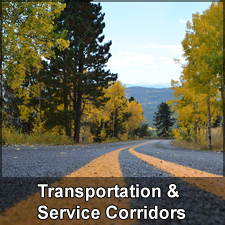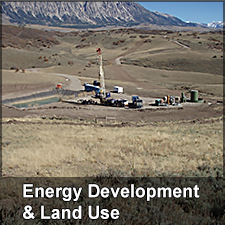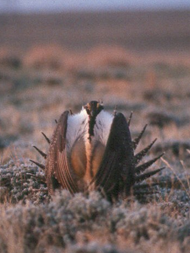Page Content
Overview
The greater sage-grouse gets its name from the sagebrush on which it depends for food and shelter. This species is found in 11 western states. Its declining population places it in Tier 1 of our SWAP species of concern, but the collaborative effort across states has prevented it from being listed under the Endangered Species Act. The sagebrush habitat that the sage-grouse relies on is in sharp decline in Colorado, and CPW and its partners are involved in a concerted effort to restore and conserve it.
Why Are Greater Sage-grouse Important?
Greater Sage-grouse are a significant indicator of the health of the sagebrush ecosystem. Over 250 species depend on this habitat including mule deer, pronghorn, elk and a wide variety of migrant and resident bird species. By managing and protecting the Sage-grouse habitat, all these other species also benefit. Greater sage-grouse also provide recreational and economic benefits through hunting and wildlife viewing opportunities.
What Are The Associated Challenges?



What Is CPW Doing?
 For over 25 years, CPW has been working to manage and protect the greater sage-grouse. Conservation easements on private lands protect the landscape from development while habitat treatments restore and protect the sagebrush ecosystem. We’ve cleared thousands of acres of encroaching pinyon-juniper forests to restore this imperiled habitat. Researchers are using GPS satellite transmitters to see if grouse are now using the restored areas. We also work to rebuild the natural flow of water to enhance Colorado’s wet meadows for grouse young.
For over 25 years, CPW has been working to manage and protect the greater sage-grouse. Conservation easements on private lands protect the landscape from development while habitat treatments restore and protect the sagebrush ecosystem. We’ve cleared thousands of acres of encroaching pinyon-juniper forests to restore this imperiled habitat. Researchers are using GPS satellite transmitters to see if grouse are now using the restored areas. We also work to rebuild the natural flow of water to enhance Colorado’s wet meadows for grouse young.
We take counts of birds on every lek, or congregation of males, in the spring during their amazing courtship displays. There are over 500 leks, so this monitoring requires many different teams and intensive effort. While it’s very common for Greater Sage-grouse populations to fluctuate, 2016 counts showed the highest sage-grouse populations yet.
We are not only focused on the greater sage-grouse within Colorado but we also collaborate on rangewide studies. Currently, we are part of an 11 state study to study genetic information found in feathers in an effort to understand how related these birds actually are. This helps show movement patterns of the species and connections across the sagebrush habitat and across all 11 states.
Local working groups have been established for five of the six greater sage-grouse populations, and these groups help to coordinate conservation planning on a local scale and keep the public informed.

